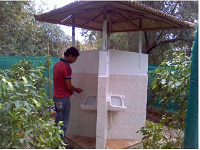Toilets and Urinals
How have India's flagship development programmes fared ? - Budget briefs on the TSC, JNNURM and MGNREGS by the Accountability Initiative
Posted on 12 Mar, 2013 11:40 AMGovernment of India’s development programmes are aimed to bring in much required inclusive development and pave a way towards an equitable and socially just society. With this motive the Centre had introduced several programmes in social sectors and allocated a fixed amount for achieving the set goals.
An analysis on the performance of the programmes shows how far the targets have been achieved, the shortcomings and the steps that are to be taken to strengthen the programmes.

Toilets in the making: Delhi Urban Art Commission (DUAC) designs eco friendly and low cost public toilets for Delhi
Posted on 01 Mar, 2013 02:06 PM

Anthropogenic activities leads to deterioration of groundwater quality: A study of Mayyanad and Edamulakkal panchayats of Kollam district in Kerala
Posted on 22 Feb, 2013 10:07 AMKerala is a rain blessed state in the country. It has highest number of wells, when compared with other states. However due to its slanting topography there is significant decline in the ground water levels leading to severe water scarcity during summer months in most districts of the state. Further over extraction and dependence of groundwater for domestic use from the dug wells especially in rural pockets has resulted in several groundwater problems. In this backdrop the paper in The Ecosan- An International Quarterly Journal of Environmental Science, sheds light on groundwater quality issues in two panchayats of Kerala.
The role of sanitation in girl child education - A documentary film by HEEALS
Posted on 15 Feb, 2013 08:31 PM
The role of sanitation in girl child education - A documentary film by HEEALS
HEEALS is a vibrant civil society organization that aims to safeguard health, environment, education and livelihood to promote sustainable development of society. Through the medium of documentary film and art it is trying to create awareness among the masses about girl child education, menstrual hygiene, sanitation and safe drinking water and attempting to relate how girl child education directly suffers due to bad sanitation facilities, unsafe drinking water and lack of knowledge to obtain the same.
Guidelines on the integrated low cost sanitation scheme by Ministry of Housing and Urban Poverty Alleviation (2012)
Posted on 11 Feb, 2013 05:41 PMThis document by Ministry of Housing and Urban Poverty Alleviation provides guidelines for the low cost sanitation scheme. The main objective of the scheme is to convert the existing dry latrines into low cost flush latrines and to construct new ones.
A communication and advocacy strategy framework for sanitation and hygiene, by the Ministry of Drinking Water and Sanitation and UNICEF (2012-17)
Posted on 05 Feb, 2013 08:44 PMThe number people practicing open defecation in India is more than 600 million. Though the access to improved sanitation has increased since 2000 the pace of change has been slow. If the current trend continues then it will be difficult for the country to meet its Millenium Development Goal for sanitation. Thus accelerating access to and use of toilets and hygiene practices have become a national priority.
A toilet that loves the environment: A film by the Himalaya Seva Sangh highlighting Uttarakhand's experience with eco-san toilets
Posted on 03 Feb, 2013 03:43 PM
The Himalayas are inhabited by 40 million people, most of whom are dependent on agriculture and animal husbandry. The prevalent water scarcity also means a lack of water for sanitation. In this case, both open defecation and conventional sewerage pose a health risk. Conventional toilets not only consume a lot of water, but the effluent also pollutes groundwater.
A resource book on waterless urinals, an ecological sanitation method that saves water, energy and uses urine as a resource
Posted on 02 Feb, 2013 05:40 PM
Waterless urinals (WLU) save water, energy and use urine as resource ( Image courtesy: R Sakthivel)
Water: Towards a paradigm shift in the Twelfth Plan - A paper by Mihir Shah in the EPW
Posted on 22 Jan, 2013 10:37 AMA fundamental change in the principles, approach and strategies of water management in India has been proposed in the Twelfth Plan
Why is this paradigm shift needed ?





